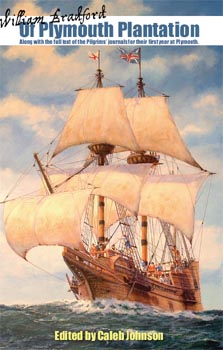In the morning we made the 30 minute drive to the parish church of Upper Clatford, where Stephen Hopkins was baptized in 1581. The discovery of the baptism of Stephen Hopkins in their church was only made within the last decade, but the church has clearly adopted their Mayflower member with more pride than most. Knowing we were coming, some of the church turned out, served us tea, coffee and cookies, gave us a full tour and history, and we shot some interviews and documentary footage there that hopefully will turn out very nice. I signed and gave them a copy of my Hopkins book, which was graciously received.
One of the individuals on the documentary team was Christian Wessling, a Wampanoag tribe member who was, like me, visiting England for the first time, and (also like me) touring England to see where some of his people went--in particular following the path of Squanto. It was an honor and treat for a Mayflower descendant such as myself, to spend Thanksgiving week with a Wampanoag, traveling through England. I had just a few weeks earlier discovered the actual site in London where Squanto was held, which he was able to visit first-hand after managing to talk himself inside! I would anticipate this would be a highlight in the documentary for sure.
After finishing up at Upper Clatford, I pointed out that on the way in we had passed the Norman Court Farm, which early manorial records indicate was the location where the Hopkins and Williams families held some farmland. The church members helped us get in touch with the land owner, who graciously allowed us inside one of the magnificent old barns on the property. What a treat!
After departing Upper Clatford, we headed to the town of Hursley, which is where Stephen Hopkins likely married his wife Mary, and where his children Elizabeth, Constance, and Giles were baptized. Mary's family had owned a tavern/inn within Hursley known as the Star Inn. It was apparently torn down at some time in the 18th century, but a nearby tavern/inn, likely of similar nature, still survives today, known as the "The Dolphin." The "Star Inn" was originally located just across the street and south a block. We ate a nice lunch here of traditional English fish and chips.
From there we headed to the parish church of Hursley, which we planned to simply photograph and take some footage. Much of the church was rebuilt in the 19th century and only the bell-tower itself has some antiquity, so visually it is not what Hopkins would have been too familiar with. But it is still the same church, on the same church site, and the bell-tower was still of interest as well.
As we were taking some photos and stock footage for the documentary, a woman walking a dog came through the churchyard, and Christian Wessling, our ever-social Wampanoag who could probably talk himself into Fort Knox, struck up a conversation that ultimately led us to the house of the churchwarden, who then took us up inside the bell-tower! What a special experience that was. The tight spiral staircase led up to a room where the bell pull-cords and clock were located, and then from there we continued up another level to the bells themselves. Two of the bells were from 1616, so perhaps Hopkins himself heard them ring out. At five o'clock PM on 24 November 2015, we were inside the bell-tower as the bells of Hursley church rang out.









